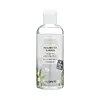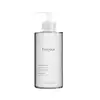What's inside
What's inside
 Key Ingredients
Key Ingredients

 Benefits
Benefits

 Concerns
Concerns

 Ingredients Side-by-side
Ingredients Side-by-side

Water
Skin ConditioningDipropylene Glycol
HumectantPEG-6 Caprylic/Capric Glycerides
EmulsifyingCamellia Sinensis Leaf Extract
AntimicrobialMalpighia Emarginata Fruit Extract
Skin ConditioningActinidia Chinensis Fruit Extract
EmollientVaccinium Angustifolium Fruit Extract
Skin ProtectingRubus Idaeus Fruit Extract
AstringentVaccinium Macrocarpon Fruit Extract
AstringentVaccinium Vitis-Idaea Fruit Extract
AntioxidantPyrus Malus Fruit Extract
Skin ConditioningCitrus Limon Fruit Extract
MaskingCitrus Aurantifolia Fruit Extract
Skin ConditioningCitric Acid
BufferingGlycolic Acid
BufferingLactic Acid
BufferingButylene Glycol
HumectantSodium Citrate
Buffering1,2-Hexanediol
Skin ConditioningCaprylyl Glycol
EmollientDisodium EDTA
Phenoxyethanol
PreservativeParfum
MaskingWater, Dipropylene Glycol, PEG-6 Caprylic/Capric Glycerides, Camellia Sinensis Leaf Extract, Malpighia Emarginata Fruit Extract, Actinidia Chinensis Fruit Extract, Vaccinium Angustifolium Fruit Extract, Rubus Idaeus Fruit Extract, Vaccinium Macrocarpon Fruit Extract, Vaccinium Vitis-Idaea Fruit Extract, Pyrus Malus Fruit Extract, Citrus Limon Fruit Extract, Citrus Aurantifolia Fruit Extract, Citric Acid, Glycolic Acid, Lactic Acid, Butylene Glycol, Sodium Citrate, 1,2-Hexanediol, Caprylyl Glycol, Disodium EDTA, Phenoxyethanol, Parfum
Water
Skin ConditioningCocamidopropyl Betaine
CleansingGlycerin
HumectantAcrylates Copolymer
Disodium Cocoamphodiacetate
CleansingMethyl Perfluoroisobutyl Ether
SolventPotassium Cocoyl Glycinate
Polyquaternium-7
Sodium Benzoate
MaskingSodium Hydroxide
BufferingParfum
MaskingCentella Asiatica Extract
CleansingXanthan Gum
EmulsifyingEthylhexylglycerin
Skin ConditioningMelaleuca Alternifolia Leaf Extract
PerfumingNymphaea Caerulea Flower Extract
Skin ConditioningSpirulina Platensis Extract
Skin ProtectingArtemisia Princeps Leaf Extract
Skin Conditioning1,2-Hexanediol
Skin ConditioningPanthenol
Skin ConditioningBrassica Oleracea Italica Extract
AstringentMedicago Sativa Extract
TonicBrassica Oleracea Capitata Leaf Extract
Skin ConditioningTriticum Vulgare Germ Extract
Skin ConditioningBrassica Campestris Extract
Skin ConditioningRaphanus Sativus Seed Extract
Skin ConditioningCoix Lacryma-Jobi Ma-Yuen Seed Extract
Skin ConditioningTriticum Vulgare Seed Extract
BufferingZea Mays Kernel Extract
Phaseolus Radiatus Seed Extract
Skin ConditioningGlycine Soja Seed Extract
Skin ConditioningOryza Sativa Bran Extract
Skin ConditioningButylene Glycol
HumectantJasminum Officinale Flower/Leaf Extract
MaskingRosmarinus Officinalis Leaf Extract
AntimicrobialLavandula Angustifolia Flower/Leaf/Stem Extract
MaskingHamamelis Virginiana Bark/Leaf/Twig Extract
Skin ConditioningEucalyptus Globulus Leaf Extract
PerfumingCalendula Officinalis Flower Extract
MaskingMentha Piperita Leaf Extract
Skin ConditioningVerbena Officinalis Leaf Extract
MaskingChamomilla Recutita Flower Extract
MaskingAspalathus Linearis Extract
Skin ConditioningRehmannia Glutinosa Root Extract
Skin ConditioningEclipta Prostrata Extract
Skin ConditioningGlycyrrhiza Uralensis Root Extract
Skin ConditioningSophora Flavescens Root Extract
AntioxidantCapsicum Annuum Fruit Extract
AntimicrobialAngelica Gigas Root Extract
Skin ConditioningPolygonum Multiflorum Root Extract
Skin ConditioningAngelica Dahurica Root Extract
Skin ConditioningLithospermum Erythrorhizon Root Extract
Skin ConditioningLycium Chinense Fruit Extract
AntioxidantMorus Alba Root Extract
BleachingRubus Coreanus Fruit Extract
Skin ConditioningCamellia Sinensis Leaf Extract
AntimicrobialCitric Acid
BufferingLactic Acid
BufferingSalicylic Acid
MaskingWater, Cocamidopropyl Betaine, Glycerin, Acrylates Copolymer, Disodium Cocoamphodiacetate, Methyl Perfluoroisobutyl Ether, Potassium Cocoyl Glycinate, Polyquaternium-7, Sodium Benzoate, Sodium Hydroxide, Parfum, Centella Asiatica Extract, Xanthan Gum, Ethylhexylglycerin, Melaleuca Alternifolia Leaf Extract, Nymphaea Caerulea Flower Extract, Spirulina Platensis Extract, Artemisia Princeps Leaf Extract, 1,2-Hexanediol, Panthenol, Brassica Oleracea Italica Extract, Medicago Sativa Extract, Brassica Oleracea Capitata Leaf Extract, Triticum Vulgare Germ Extract, Brassica Campestris Extract, Raphanus Sativus Seed Extract, Coix Lacryma-Jobi Ma-Yuen Seed Extract, Triticum Vulgare Seed Extract, Zea Mays Kernel Extract, Phaseolus Radiatus Seed Extract, Glycine Soja Seed Extract, Oryza Sativa Bran Extract, Butylene Glycol, Jasminum Officinale Flower/Leaf Extract, Rosmarinus Officinalis Leaf Extract, Lavandula Angustifolia Flower/Leaf/Stem Extract, Hamamelis Virginiana Bark/Leaf/Twig Extract, Eucalyptus Globulus Leaf Extract, Calendula Officinalis Flower Extract, Mentha Piperita Leaf Extract, Verbena Officinalis Leaf Extract, Chamomilla Recutita Flower Extract, Aspalathus Linearis Extract, Rehmannia Glutinosa Root Extract, Eclipta Prostrata Extract, Glycyrrhiza Uralensis Root Extract, Sophora Flavescens Root Extract, Capsicum Annuum Fruit Extract, Angelica Gigas Root Extract, Polygonum Multiflorum Root Extract, Angelica Dahurica Root Extract, Lithospermum Erythrorhizon Root Extract, Lycium Chinense Fruit Extract, Morus Alba Root Extract, Rubus Coreanus Fruit Extract, Camellia Sinensis Leaf Extract, Citric Acid, Lactic Acid, Salicylic Acid
Ingredients Explained
These ingredients are found in both products.
Ingredients higher up in an ingredient list are typically present in a larger amount.
1,2-Hexanediol is a synthetic liquid and another multi-functional powerhouse.
It is a:
- Humectant, drawing moisture into the skin
- Emollient, helping to soften skin
- Solvent, dispersing and stabilizing formulas
- Preservative booster, enhancing the antimicrobial activity of other preservatives
Butylene Glycol (or BG) is used within cosmetic products for a few different reasons:
Overall, Butylene Glycol is a safe and well-rounded ingredient that works well with other ingredients.
Though this ingredient works well with most skin types, some people with sensitive skin may experience a reaction such as allergic rashes, closed comedones, or itchiness.
Learn more about Butylene GlycolCamellia Sinensis Leaf Extract is derived from the leaves of the tea plant. Black tea, green tea, and oolong tea are all harvested from this plant.
This ingredient has many skin benefits:
This ingredient contains polyphenols, a strong antioxidant. Antioxidants help fight off molecules that damage skin cells.
On top of that, the antioxidants in green tea neutralize free-radicals from the sun. This gives the skin some extra UV protection, but should not replace sunscreen.
Many components of tea have anti-inflammatory properties.
Polyphenols and L-theanine help soothe the skin and reduce irritation. The caffeine in Camellia Sinensis Leaf Extract helps calm inflamed blood vessels.
Other compounds found in tea include: Vitamin Bs, linoleic acid, magnesium, calcium, iron, and zinc.
Research has shown both drinking Camellia Sinensis Leaf Tea and applying it to the skin can help boost skin elasticity and hydration. Studies also show using tea extract may reduce sebum, or oil, production.
Learn more about Camellia Sinensis Leaf ExtractCitric Acid is an alpha hydroxy acid (AHA) naturally found in citrus fruits like oranges, lemons, and limes.
Like other AHAs, citric acid can exfoliate skin by breaking down the bonds that hold dead skin cells together. This helps reveal smoother and brighter skin underneath.
However, this exfoliating effect only happens at high concentrations (20%) which can be hard to find in cosmetic products.
Due to this, citric acid is usually included in small amounts as a pH adjuster. This helps keep products slightly more acidic and compatible with skin's natural pH.
In skincare formulas, citric acid can:
While it can provide some skin benefits, research shows lactic acid and glycolic acid are generally more effective and less irritating exfoliants.
Most citric acid used in skincare today is made by fermenting sugars (usually from molasses). This synthetic version is identical to the natural citrus form but easier to stabilize and use in formulations.
Read more about some other popular AHA's here:
Learn more about Citric AcidLactic Acid is another well-loved alpha hydroxy acid (AHA). It is gentler than glycolic acid but still highly effective.
Its main role is to exfoliate the surface of the skin by loosening the “glue” that holds dead skin cells together. Shedding those old cells leads to smoother, softer, and more even-toned skin.
Because lactic acid molecules are larger than glycolic acid, they don’t penetrate as deeply. This means they’re less likely to sting or irritate, making it a great choice for beginners or those with sensitive skin.
Like glycolic acid, it can:
Lactic acid also acts as a humectant (like hyaluronic acid). It can draw water into the skin to improve hydration and also plays a role in the skin's natural moisturizing factor (NMF) in the form of sodium lactate.
Studies show it can boost ceramide production to strengthen the skin barrier and even help balance the skin’s microbiome.
To get results, choose products with a pH between 3-4.
Lower strengths (5-12%) focus on surface exfoliation; higher strengths (12% and up) can reach deeper in the dermis (deeper, supportive layer) to improve skin texture and firmness over time.
Though it was originally derived from milk, most modern lactic acid used in skincare is vegan. It is made through non-dairy fermentation to create a bio-identical and stable form suitable for all formulations.
When lactic acid shows up near the end of an ingredient list, it usually means the brand added just a tiny amount to adjust the product’s pH.
Legend has it that Cleopatra used to bathe in sour milk to help reduce wrinkles.
Lactic acid is truly a gentle multitasker: it exfoliates, hydrates, strengthens, and brightens. It's a great ingredient for giving your skin a smooth, glowing, and healthy look without the harshness of stronger acids.
Read more about some other popular AHA's here:
Learn more about Lactic AcidParfum is a catch-all term for an ingredient or more that is used to give a scent to products.
Also called "fragrance", this ingredient can be a blend of hundreds of chemicals or plant oils. This means every product with "fragrance" or "parfum" in the ingredients list is a different mixture.
For instance, Habanolide is a proprietary trade name for a specific aroma chemical. When used as a fragrance ingredient in cosmetics, most aroma chemicals fall under the broad labeling category of “FRAGRANCE” or “PARFUM” according to EU and US regulations.
The term 'parfum' or 'fragrance' is not regulated in many countries. In many cases, it is up to the brand to define this term.
For instance, many brands choose to label themselves as "fragrance-free" because they are not using synthetic fragrances. However, their products may still contain ingredients such as essential oils that are considered a fragrance by INCI standards.
One example is Calendula flower extract. Calendula is an essential oil that still imparts a scent or 'fragrance'.
Depending on the blend, the ingredients in the mixture can cause allergies and sensitivities on the skin. Some ingredients that are known EU allergens include linalool and citronellol.
Parfum can also be used to mask or cover an unpleasant scent.
The bottom line is: not all fragrances/parfum/ingredients are created equally. If you are worried about fragrances, we recommend taking a closer look at an ingredient. And of course, we always recommend speaking with a professional.
Learn more about ParfumWater. It's the most common cosmetic ingredient of all. You'll usually see it at the top of ingredient lists, meaning that it makes up the largest part of the product.
So why is it so popular? Water most often acts as a solvent - this means that it helps dissolve other ingredients into the formulation.
You'll also recognize water as that liquid we all need to stay alive. If you see this, drink a glass of water. Stay hydrated!
Learn more about Water